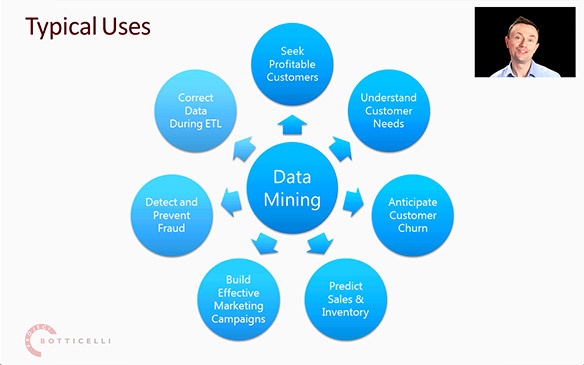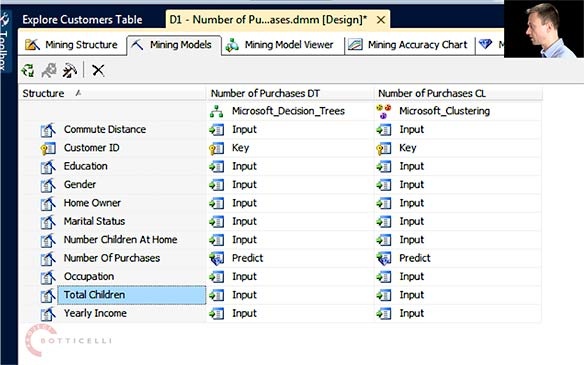New Data Mining Online Training Launched
When you registered on ProjectBotticelli.com, you asked to be notified about new content. This is our fifth newsletter since we have launched our site.
Summary of New Content:
- Introduction to Data Mining with SQL Server 2012 (20 min)
- Data Mining Concepts and Tools (50 min)
- Updated PPTs from BI and Productivity Roadshow 2012, covering SQL Server 2012
News
Gartner's Rita Sallam has claimed, last month, that Predictive Analytics is the next big business intelligence trend, defining it as "the analysis of structured and unstructured data using statistics, descriptive and predictive data mining, simulation and optimization to produce insights that query and reporting tools are unlikely to discover." Aberdeen Research proclaimed, in their February report, titled Predictive Analytics Defining Marketing Competition, that "Leaders in predictive analytics for marketing have distinct advantages in customer value, retention and data insight." Netflix published a blog, in April, how a drive for more accuracy in their in-house data mining is core to their business and profitability, sharing an interesting, and a precise, metric of their success.
In short, data mining is, at long last, becoming a hot subject again, tempered by its former hype, but now with a claim to real-world successes. For that reason, we are delighted to launch our newest addition online: a brand-new Data Mining training course. Since I delivered my first data mining sessions seven years ago, I have been frequently asked to provide a video recording of those. It is with a great pleasure, that this long-planned series is off the ground with two modules to get you started: Introduction to Data Mining with SQL Server 2012 and Data Mining Concepts and Tools. We plan to add more modules in this series over the course of this year, hopefully one per month, or so. There is very little online data mining training, and while this series focuses on SQL Server's data mining engine, the concepts are more generic, and apply to the entire discipline.
If you want to follow our demos, you can use the well known Adventure Works DW samples, available from Codeplex, or our own data set, HappyCars, available for download to Full Access Members (links are in the article under the video).
Special Offer—10% Discount
To celebrate the launch of a new training course, we are happy to offer a 10% discount on all memberships—use coupon code DM2012LAUNCH at checkout. This code expires on 30 June 2012. Feel free to share it, or tweet it. If you are not sure if this course is right for you, go ahead and watch the first free video in the series. And if you are a Full Access Member, you can always use this code to extend your current membership at a discount.
Group Membership
If you work for a company, Data Mining training could be useful to your colleagues. You can get Full Access Membership for multiple users by purchasing a discounted Group Membership pack. It is very simple: buy a pack, receive pre-paid membership codes for your users, then each user redeems a code. You also get one tax invoice for the whole purchase and everyone looks after their own usernames, passwords, and preferences. Above all, buying a Group Membership is cheaper than buying individually, and—until the end of June—you can even use that 10% off code, mentioned above.
New Content in More Detail
The first module of our Data Mining tutorial introduces easy-to-use data mining tools in Microsoft SQL Server, requiring very little formal knowledge of the subject to get started. Our goal is to explain how to perform advanced analytics of your own data. We cover: what is data mining, why would you use it, and how it is related to Big Data analytics. There are two short demos, Anomaly (Outlier) Detection with Excel and Data Mining Add-ins, and Market Basket Analysis using SQL Server Data Tools and Association Rules algorithm.
The second module of the course focuses on the fundamental concepts of data mining, including Cases, Mining Structures, Models, Algorithms, Data and Content Types, Discretization, Distributions, and more. You also see SQL Server Data Tools (SSDT), the successor to BI Development Studio (BIDS), in more detail. We briefly introduce 9 of the Microsoft data mining algorithms: Naïve Bayes, Clustering, Decision Trees, Association Rules, Sequence Clustering, Neural Networks, Logistics Regression, Linear Regression, and Time Series. They will be explained in more detail in future modules of this series.
Request for Feedback
Do the videos play smoothly, and is the resolution really good? They are supposed to switch bitrate automatically to match your bandwidth conditions, but only you can give realistic feedback about that. Is anything behaving not as you would expect it to, or have you experienced any technical glitches with the site? We know you have high expectations, just as you do when you attend our high-quality conference presentations. Do you like anything in particular, or is something perhaps not so convenient for you? We would be extremely grateful if you would let us know any suggestions or comments you have—just email me: simply hit Reply, and even a one-liner will be much appreciated.
Thanks for reading and we hope you enjoy being a Full Access Member,
Rafal Lukawiecki, Strategic Consultant and Director, Project Botticelli Ltd

